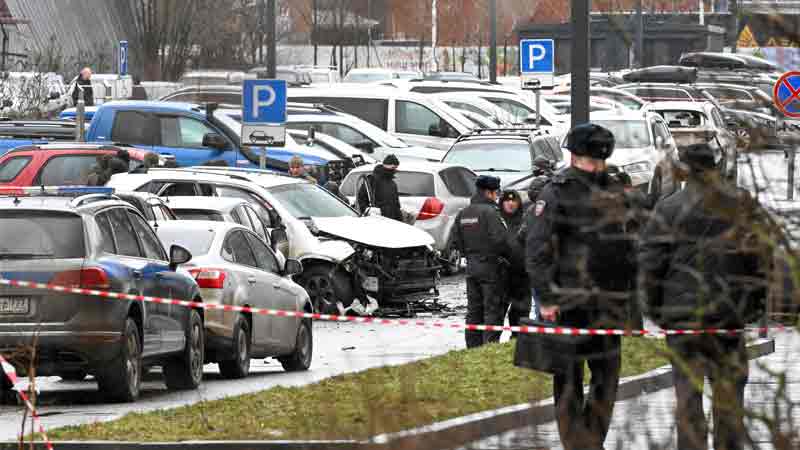The federal government announced new regulations this week requiring all passenger vehicles built in 2029 and beyond to have automatic emergency braking technology installed.
“Automatic emergency braking (AEB) is proven to save lives and reduce serious injuries from frontal crashes, and this technology is now mature enough to require it in all new cars and light trucks,” claimed National Highway Traffic Safety Administration Deputy Administrator Sophie Shulman.
“Making this safety feature standard, rather than a luxury, is part of the Department’s National Roadway Safety Strategy to address the crisis of deaths on our roads,” the NHTSA website reads.
Celebrating the decision to put people’s lives in the hands of AI, Biden Transportation Secretary Pete Buttigieg stated, “We’re ushering in a new era of safer travel by ensuring new cars and light trucks are equipped with automatic emergency braking.”
We’re ushering in a new era of safer travel by ensuring new cars and light trucks are equipped with automatic emergency braking. We estimate this rule will save hundreds of lives & prevent thousands of injuries every year. https://t.co/yUNUIW7clw
— Secretary Pete Buttigieg (@SecretaryPete) April 29, 2024
“We estimate this rule will save hundreds of lives & prevent thousands of injuries every year,” Buttigieg added.
In a video shared by Buttigieg attempting to justify the rule, surveillance footage shows a child who appears to be jaywalking being hit by a vehicle driven by an unlicensed driver.
We have a crisis of roadway deaths in this country—and today we’re taking a major step toward addressing this with our new rule on automatic emergency braking. pic.twitter.com/NRS8WJeA6o
— Secretary Pete Buttigieg (@SecretaryPete) April 30, 2024
NHTSA claims requiring the automatic breaking system would “save at least 360 lives a year and prevent at least 24,000 injuries annually.”
The AEB system works by abruptly braking a driver’s vehicle if infrared sensors detect an object directly ahead, ostensibly preventing rear-end collisions and pedestrian crashes.
The NHTSA is moving forward with its plan despite the agency’s long documentation of issues and crashes caused by the AEB systems.
Reports earlier this month revealed the NHTSA opened an investigation into problems with the AEB system in certain Honda vehicles and “phantom braking.”
“The complaints allege that the automatic emergency braking system can brake the vehicles with nothing in their forward path, increasing the risk of a crash,” reported the AP. “The agency said it has 47 reports of crashes and 112 reports of injuries from the problem.”
The NHSTSA is also investigating several Tesla models for AEB problems.
Automotive-Fleet.com reports a similar AEB issue unfolded with Nissans in 2018:
In 2018, Nissan announced a recall of more than 100,000 Rogue vehicles due to an issue with the AEB system that could cause it to activate unexpectedly, resulting in unnecessary braking. The recall was intended to address a software error that could cause the AEB system to misinterpret certain objects, such as roadside objects, as obstacles and apply the brakes, even if no actual threat of collision existed.
While the issue was addressed through the recall, other reports of phantom braking incidents in the Nissan Rogue and other Nissan models have surfaced in recent years.
Notably, phantom braking incidents can occur in any vehicle with an AEB system, and they are not necessarily a reflection of a particular brand or model’s reliability or safety.
Read an excerpt of this person’s horror story on Reddit about his ordeal with his AEB system in downtown San Francisco:
On Wednesday I was driving up a San Francisco hill in rush hour. Since it was rush hour, we weren’t moving very fast (maybe 15mph when the light was green) and traffic was densely packed in so there was only maybe 10 feet front and back from me to the other cars. Suddenly out of nowhere, the car completely slams on the brakes. 15mph-0mph instantly, full wheel lock. The cars in front of me continue up the hill. My seat belt catches. “⚠️ Engaging automatic emergency braking” or something like that pops up on the screen. I don’t know how, but somehow the person behind me was able to stop in time mere inches off my bumper. I can’t move. I pressed the accelerator pedal – nothing. I checked my drive selector – yep I’m in Drive. I tried tapping the brake to release the hold – nothing. Finally the car started rolling again and I was able to continue up the hill very thankful no one slammed into me.
Time will tell whether the agency’s rule will cause more accidents than it claims it will prevent.




